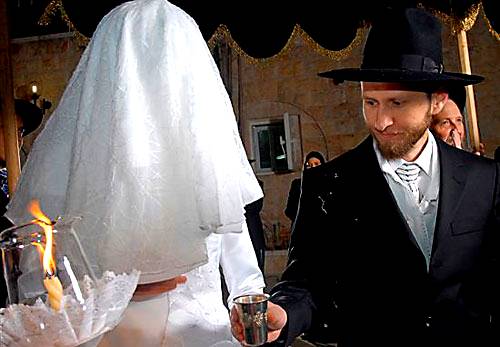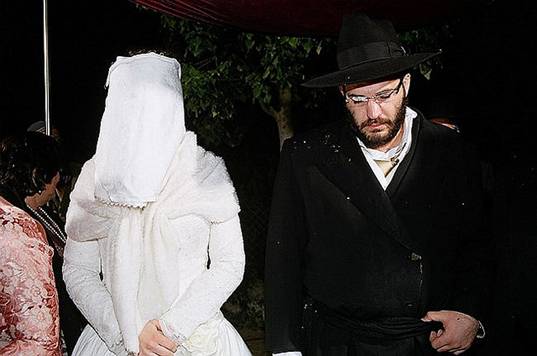Chapter II
The Jewish women who are taking the veil
1. Jewish Taliban Girls

These photos published in a haredi forum show the junction Mea Shearim Street / Shivtei Israel. However, I don't think that the two children in the photo belong to Chassidut Toldot Aharon owning the property right next to where the kids walk. I rather assume that the covered Taliban looking girl and her brother belong to the Ba'alei Teshuva movement from Breslov. Those people mainly live in one of the streets across where they also have their own school.
I have seen you a few girls whose Breslov Ba'al Teshuva mother is raising them by wearing thick scarfs and a bundle of Taliban clothes. There are two young sister in the Nachlaot neighbourhood wearing the same kind of clothing.
To this end, we recommend the book called Hide and Seek published by Urim Publications. It is a collection of essays, primarily by women, on hair covering, with a halachic summary in the introduction.
For an English-language discussion of the relevant sources, we recommend the first chapter of Understanding Tzniut, by our rabbinic supervisor Rav Yehuda Henkin (published by Urim). Also of interest by Rav Henkin is Responsa on Contemporary Jewish Women's Issues (published by Ktav), chapters 16-17.
1.1 Women wearing Re’ulot
I found an interesting teaching in the Talmud Tractate Shabbat 65a which immediately reminded me of the "Taliban Mother".
The Mishna says that Jewish women may go out on Shabbat wearing "Re'ulot".
What does this mean ?
Rashi explains that it refers to women whose entire head is totally covered except for one eye. However, this way of dressing is considered provocative, as it entices men wanting to see more of the face.
Honestly, I have never thought about that !:-)
This is why it is called "Re'ulot - Poisons". Further, Rashi says that "Re'ulot" are thick coats a woman wraps around herself. On the other hand, the Rambam considered "Re'ulot" to be bells hanging from the woman's clothes.
The thought that men who see a today's Jewish Burka woman may feel the desire to see more ... Maybe this was true in ancient times but not today. The Breslover Burka women running around in Beit Shemesh, Jerusalem or elsewhere probably cause the opposite, as there is nothing female around them. Not even anything human but just a walking Schmattes.
And here is a picture of orthodox jewish women covering their bodies from head to toe with burqas in Jerusalem..even the little girls!
Interesting. If you didn't say they were Jewish I would have immediately assumed those were Muslims.
Newly-religious women walking around covered head-to-toe in black clothes are growing in numbers. Even six-year-old girls are made to hide their faces. Haredi rabbis finally condemn growing trend
They arrive there every morning, girls aged six to 10 covered head to toe, their faces hidden behind a veil similar to a hijab. They enter an apartment at the center of Jerusalem, which serves as their school.
Hundreds of people see them walk by, including Education Ministry employees who work nearby. Somehow, though, they never seem to do anything about it.

So far, one has only heard of "Taliban mothers," haredi women covered head to toe, including a headscarf, much like Afghani women living under Taliban rule. But now one finds little girls too, the daughters of these "Taliban mothers," walking around outdoors in full body coverage.
Since no haredi school is willing to let these girls in, they go to improvised schools in Beit Shemesh and Jerusalem founded especially for them by their mothers. Needless to say these schools and the curriculum are not supervised by the Education Ministry.
This phenomenon has raised many eyebrows within the haredi community. "Taliban women" and their daughters are outcasts on haredi streets. They encounter looks of disgust, bullying and constant humiliation.
M., a member of the anti-Zionist Hasidic movement Toldos Aharon, lives in Jerusalem. He said he has seen young men come up to these women trying to pull off their head covers.
"There are guys who will approach a woman and say things like: 'You look like a suicide bomber' or 'I guess your face is ugly if you keep it hidden.' There are also those who spit on them and curse at them, or just badger them with cameras so they'll run away."
'Back to sacred custom'

The fact that most of the "Taliban women" are newly-religious does not help either. "It's unacceptable that that the newly-religious will tell us that our women aren't modest and good enough," a senior haredi businessman explained.
It does make sense however that these women are newly-religious. Extremism is very common amongst people who change their lifestyle in a radical manner, from a secular life to a religious one and vise-versa.
"Similar to those who search for meaning in their lives or feel lost and seek help, these girls are inspired by a dominant figure," said a father of a newly-religious girl who now belongs to a cult. "I personally feel that in both cases it's a matter of exploiting weaknesses, but ultimately my daughter is happy and pleased with the life she has chosen, so I have to accept it."
His daughter, however, sees nothing wrong with her unusual appearance. "I think that seculars, who are used to seeing girls dressed in minimal clothing, are the weird ones," she said. "As far as I'm concerned, I'm following the rules of modesty which

ones," she said. "As far as I'm concerned, I'm following the rules of modesty which are also meant to save men from themselves. A man who sees a woman's body parts is sexually aroused, and this might cause him to commit sin. Even if he doesn't actually sin physically, his impure thoughts are sin in themselves."
But what about little girls? Why do 6-year-olds need to walk around covered head-to-toe? "There are enough men who look at them as sexual objects. Such values must be taught at an early age," she explained.
Husbands of the "Taliban women" usually accept the way their wives dress. "Some of them do it out of weakness and lack of choice, others claim they put up with it because of a higher calling and purity. I think they are simply weak. If we're being honest, haredi men are not involved with what goes on at home. They spend most of their days in their yeshivot."
Even though it is quite clear that the Haredi community condemns this trend, the usual frothing anti-religious shriekers at YNet are blaming the entire Haredi community for "forcing" this unusual custom upon their helpless women. Therefore take the comments with a grain of salt
Ultra-Orthodox Jewish Women
Naomi Mahfud (RNaomi Mahfud (R) and Revital (last name was not given) Ultra Orthodox Jewish women, belonging to a small group of women who cover their
 entire bodies with a long cape-like garment from head to toe that conceals their figures, as an extreme act of modesty ,known as the “Jewish Taliban women” or the “veil cult”.
Photo by: Einat Keinan & Juliane von Mittelstaedt
entire bodies with a long cape-like garment from head to toe that conceals their figures, as an extreme act of modesty ,known as the “Jewish Taliban women” or the “veil cult”.
Photo by: Einat Keinan & Juliane von Mittelstaedt
Ultra-Orthodox Jews In Jerusalem
An Ultra-Orthodox Jewish woman that belongs to an extreme sect that is nicknamed "the Jewish Taliban" walks with her face and body completely covered on the Jewish holiday of Purim in the Mea Shearim neighborhood in Jerusalem, March 9, 2012. The festival of Purim commemorates the rescue of Jews from genocide in ancient Persia as told in the book of Esther. UPI/Debbie









 رد مع اقتباس
رد مع اقتباس








































المفضلات